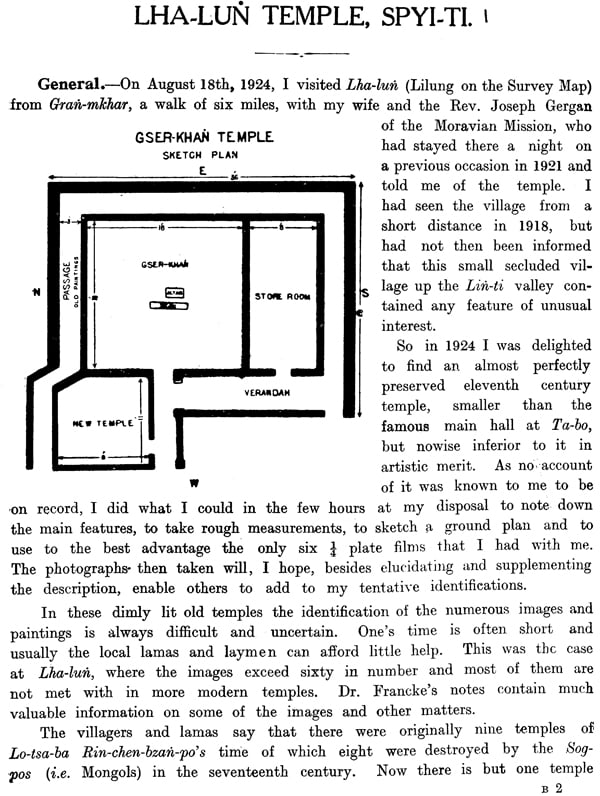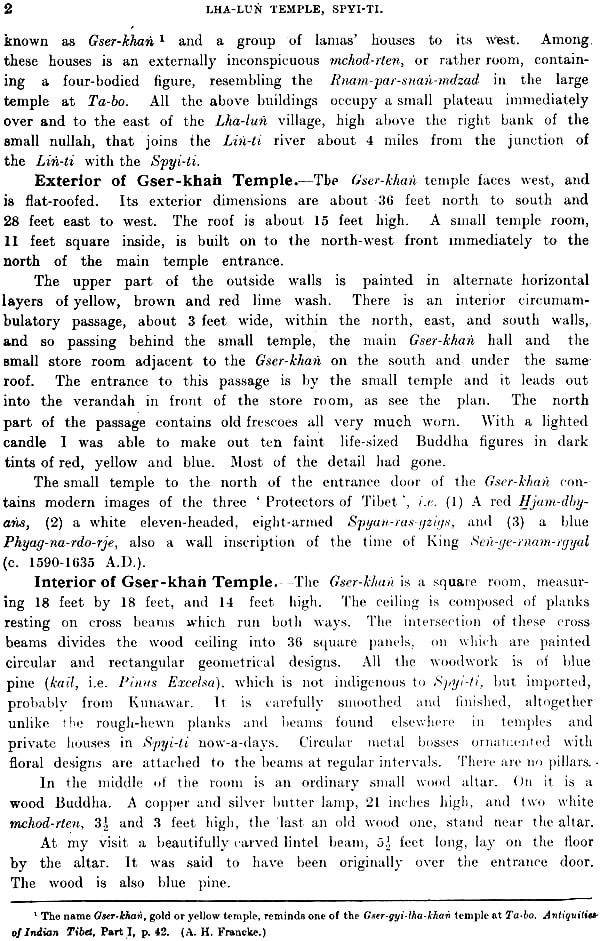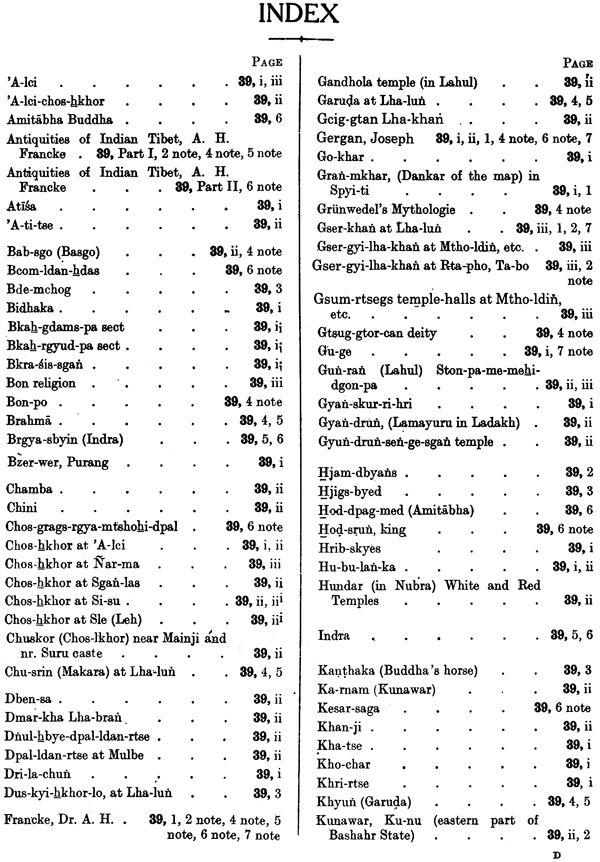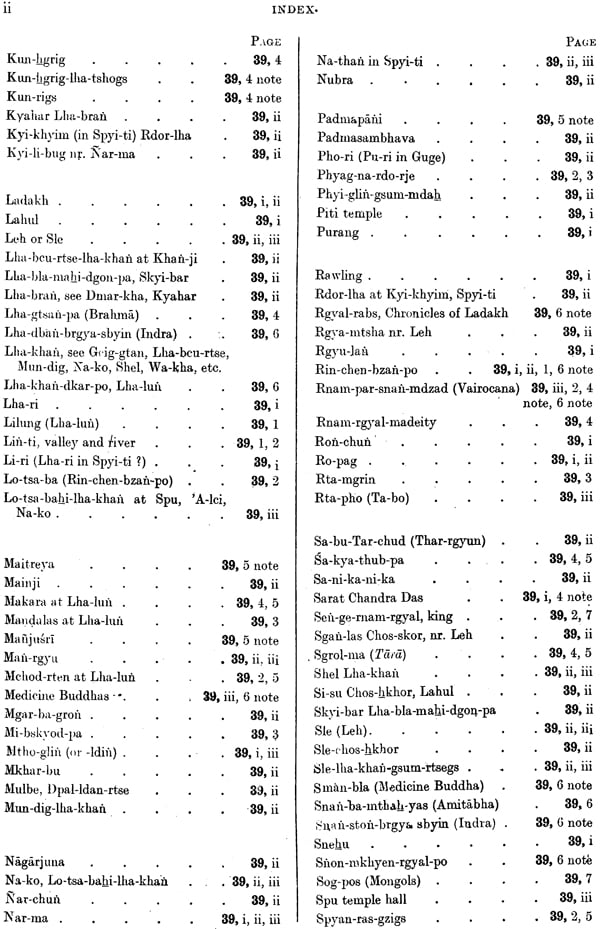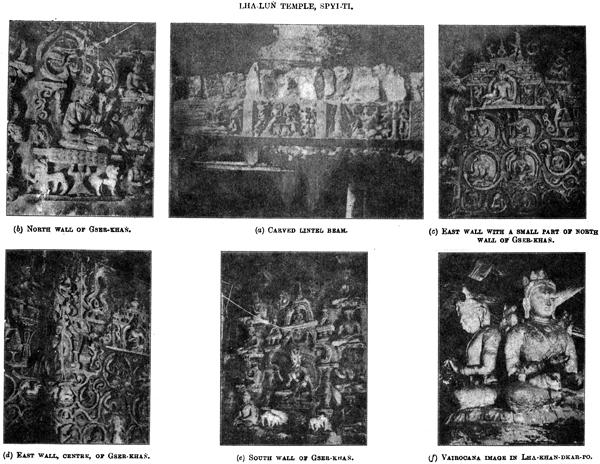
Lha-Lun Temple, Spyi-Ti
Book Specification
| Item Code: | NAM250 |
| Author: | H. Lee Shuttleworth |
| Publisher: | Archaeological Survey of India |
| Language: | English |
| Edition: | 1998 |
| Pages: | 18 (7 B/W Illustrations) |
| Cover: | Hardcover |
| Other Details | 11.0 inch X 9.0 inch |
| Weight | 350 gm |
Book Description
Mr. Lee Suttleworth's account of the Lha-lun temple in Spyi-ti is of great importance with regard to the study of the Atisa times of Tibetan Buddhism. The first scholar who told us something of those times was Sarat Chandra Das, who in 1893 published the little pamphlet Indian Pandits in the Land of Snow. Unfortunately he does not tell us from what sources he drew his information. In this article occasional mention is made of Rin-chen-bzam-po (956- 1054 A.D.), a Tibetan priest who had been sent to India to study Sanskrit at Vikramasila, one of the last centres of Indian Buddhism.
When travelling about in Ladakh, Spyi-ti, etc., between 1896 and 1914, I came occasionally to places which people connected with Rin-chen-bzan-po, and a closer study of such sites, first of all of ‘A -lci in Ladakh, convinced me of the fact that a good number of relics of the eleventh century bad escaped the ravages of time.
It was then my earnest desire to get some reliable information about Rin-chen-bzan-po ; but only in 1926 was I enabled to study the biography of this famous lama, which had been discovered, copied and translated by Joseph Gergan of the Moravien Mission. From this book we learn that, Rin- chen-bzan-po obtained for Tibet the services of 32 Kashmiri Buddhist artists who were clever at making images, and that the best of them was called Bidhaka. At first three principal monasteries were erected, those of Kho-char in Purang, of Mtho-glin (or -ldin) in Guge, and of Nar-ma in Ladakh.
Still later, 108 smaller temples were built, of which only the following names are given: (1) Bzer-wer in Purang, (2) Go-khar of Kha-tse, (3) Pi-ti, (4) Li-ri, (5) Ta-pho, (6) Te-ri, (7) Zad-wan, (8) Snehu, (9) Ti-yag, (10) Tshans-med, (11) Pho-ri, (12) Gyan-skur-ri-hri, (13) Rgyu-lan, (14) Ro-pag, (15) Hu-bu-lan-ka, (16) Dri- la-chun, (17) most of the temples of Ron-chun (on the Sutlej near Hrib-skyes).
Of the above names, the following only, can be identified: Mtho-glin in Guge is the Totling of the maps, a place recently visited by Rawling, Young, Even Hedin and others. Nar-rna was discovered a few years ago by Joseph Gergan as a ruined site near Khri-rtse in Ladakh.: Three of the names of the list evidently refer to Spyi-ti; viz. Pi-ti, Li-ri and Ta-pho. Pi-ti stands apparently for the capital of Spyi-ti, Gran-mkhar. Therefore, I suppose that it points to Lha-lun, a temple close to Gran-nkhar. Li-ri may be a mistake for Lha-ri in Spyi-ti, and Ta-pho evidently stands for Rta-pho. I venture even to say that Pho-ri may be identical with Pu-ri in Guge (see Antiquities of Indian Tibet, I, p. 27). In all these places, with the exception of Lha-ri ancient temples of the eleventh century have been observed. Ro-pag is stated by Joseph Gergan to be in Kunawar, and Hu-bu-lan-kar near Chini. Joseph Gergan, in his account of the Nar-ma ruins, produces another list of temples of Rin-chen-bzan-po, as follows: (I)' A -lci-chos-hkhor, l2) Phyi-glin-gsum mdah, (3) Man-rgyu, (4) Wan-la, (5) Gyun-drun, (6) 'A-ti-tse, (7) Dnul-hbye-dpal-ldan-rise, (8) Sa-bu-Tar-chud (or Thar-rgyun)-lha-khan, (9) Sle-lha-khan-gsum-risegs, (10) Sle-chos-hkhor. All these temples belong to Ladakh, are in easy reach and most of them have been examined.
Besides these, the following temples were reported or proved to be of the eleventh century: (I) Sa-ni-Ka-ni-ka in Zans-dkar (before restoration), (2) the ruin east of Bab-sgo, (3) Rgya-mtsha ruin north of Leh, (4) Lha-khan of Shel, (5) the Lha-bcu- rise-lha-khan of Khan-ji, (6) the Mun-dig-lha-khan 'ruin in the Mkhar-bu valley, (7) the Lha-khan-gog-po ruin of Wa-kha, (8) Ston-pa-me-mehi-dgon-pa of Gun-ran, (9) the ruined Lha-khan of Gcig-gtan, (10) Chos-hkhor of Si-su, (U) Ka-rnam of Kunawar, (12) Lo-tsa-bahi-lha-khan of Na-ko, (15) Lha-bran of Kyahar, (16) Na-than in Spyi-ti, (17) Lha-bla-mahi-dqon-pa of Skyi-bar.
In his notes on Rin-chen-bzan-po's biography, Joseph Gergan gives another 'list of more than 30 temples of Rin-chen-bzam-po. Most of the names are repetitions from his other lists. The following may be new. Nar-chun, Bkrasis-sgan, Dben-sa, Mgar-ba-gron, Kyi-li-bug (all in the immediate' neighbour': hood of Nar-ma), Chos-skor(-hkhor) at Sgan-las near Leh, White Temple of Hundar (Nubra), Red Temple of Hundar (Nubra); Lha-bran of Dmar-kha, Rdor-lha of Kyi-khyim (Spyi-ti), Dpal-ldan-rtse of Mulbe.
Let me add that the name of Chos-skor(-hkhor) occurs twice as a local name in the Muhammadan Suru valley. One is found on the map (Chuskor) close to Suru castle, and another close to Mainji. They are probably the sites of similar temples.
As, however, Rin-chen-bzan-po was not the only priest who erected temples in the eleventh century, but as the fathers of the Bkah-rgyud-pa sect did the same, it is not clear in several cases to which of the two sources a, certain temple owes its origin. Thus with regard to the Gyun-drun-sen-ge-sgan temple, the temples of Wan-la, Khan-ji and Gcig-gtan, I was informed that they were connected with the Bkah-gdams-pa school (Bkah-gdams-pa). And so it may be with several others .
Let me also emphasize that the eleventh century is by no means the earliest era of Buddhist temples, in the ancient West Tibetan empire. A good number are asserted to have been erected by Padmasambhava in the eighth century; and the temples of Triloknath in Chamba and Gandhola in Lahul aim to go back to the times of Nagarjuna. As Dr. J. Ph. Vogel points out, Triloknath is a place, where the ancient Indian Buddhism was gradually moulded into Lamaism. A comparative study of all the eleventh century temples of Ladakh will in course of time enable us to distinguish them from temples of other times. Only a few characteristics may now be pointed out.
They may consist of a single hall or of a collection of such surrounded 'by a wall. The door in many cases opens towards the east.
Vairocana (Rnam-par-snan-mdzad) was apparently a favoured deity in them. Several temples were called after him. Compare the following :-( 1) Mtho-ldin (-glin), (2) Ta-bo (Rta-pho), (3) Lha-lun, (4) Na-ko, (5) Gun-ran, (6) 'A-lci, (7) Man- rgyu, (8) Phyi-glin-gsum-mdah. Halls called Gser-(gyi-lha)-khan are found at Mtho-ldin, Rta-pho, Lha-lun. Halls called Lo-tsa-bahi-lha-khan (temple of the translator) are found at Spu, 'A -lci, Na-ko. Similarly we find halls with the title ston-pa, teacher, at Gun-ran and Shel. Halls called Chos-hkhor are found at Nar-ma, Si-su,' A-lci, ,Sle (Leh), This name refers to a passage built for the circumambulation of the pilgrims. Halls called Gsum-rtsegs, three-storied, were found at Mtho-ldin, Sle (Leh), 'A-lci, No-than,
The medicine Buddhas in paintings or images were found at Lha-lun and Rta-pho and probably also occur in other temples.
The leading fossil, so to say, we probably have in the Rnam-par-snan-mdzad, which may be discovered in many more of Rin-chen-bzam-po’s temples. And, as has been pointed out in Mr. Shuttleworth's article, this deity was of great importance in the eleventh century to show the Tibetans a way from the Bon 'religion to Buddhism.
| Preface | i |
| Lha-lun temple Spyi-ti : General | 1 |
| Exterior of Gser-khan temple | 2 |
| Interior of Gser-khan temple | 2 |
| Lha-lun-dkar-po | 6 |
| Index | i |
